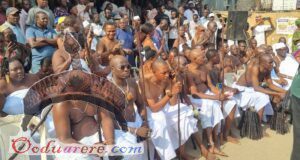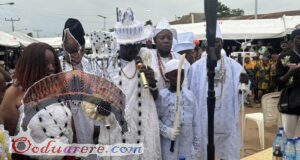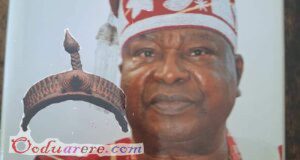The Ambassador of Cuba honored World Sango Festival 2016 with his visit and participation.
Afro-Cuban religions known as Santería are a blend of native Yoruba religion of the African Slaves with Catholicism.
The slaves carried with them various religious customs and divination system for communicating with their ancestors and deities and sacred drumming and dance. The need to preserve their traditions and belief systems in a hostile cultural environment prompted slaves in Cuba, starting from as early as 1515, to merge their customs with aspects of Roman Catholicism which are widely practiced in Cuba.
The colonial period from the standpoint of African slaves may be defined as a time of perseverance. Their world quickly changed. Tribal kings and their families, politicians, business and community leaders all were enslaved and taken to a foreign region of the world. Religious leaders, their relatives and their followers were now slaves. Colonial laws criminalized their religion. They were forced to become baptized and worship a God their ancestors had not known who was surrounded by a pantheon of saints..
A sense of hope was sustaining the internal essence of what today is called Santería, for the indigenous religion of the Lukumi people of Yoruba land. In the heart of their homeland, they had a complex political and social order. They were a sedentary hoe farming cultural group with specialized labor. Their religion, based on the worship of nature, was renamed and documented by their masters. The orisas became known as the saints in image of the Catholic pantheon. Spanish colonial planters who saw their African slaves celebrating on saints’ days did not know that they were actually performing traditional rites related to Orisa, and assumed that they were showing more interest in the Christian God—hence the derisory origin of the term Santería and it is also a Spanish word that means the worship of Saints.
Sango, today makes part of the culture, tradition and religion of Cuba and is venerated in Santería (known as Changó or Xangô ; and also known as Jakuta) . He is syncretized with either the Catholic Saint Barbara or Saint Jerome.
 Ọmọ Oòduà Naija Gist | News From Nigeria | Entertainment gist Nigeria|Networking|News.. Visit for Nigeria breaking news , Nigerian Movies , Naija music , Jobs In Nigeria , Naija News , Nollywood, Gist and more
Ọmọ Oòduà Naija Gist | News From Nigeria | Entertainment gist Nigeria|Networking|News.. Visit for Nigeria breaking news , Nigerian Movies , Naija music , Jobs In Nigeria , Naija News , Nollywood, Gist and more









